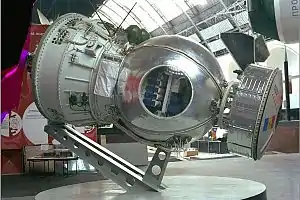Kosmos 782
Kosmos 782 (in Russian: Бион 3, Космос 782, or Bion 3) was a Bion satellite. It carried 14 experiments prepared by seven countries in all, with participation from scientists in France, Czechoslovakia, Hungary, Poland, Romania, United States and the Soviet Union.
 On display at the Moscow Space Museum, the circular viewport was installed for display purposes. | |
| Names | Бион 3 Космос 782 Bion 3 Biocosmos 3 Biokosmos 3 |
|---|---|
| Mission type | Bioscience |
| Operator | Institute of Biomedical Problems |
| COSPAR ID | 1975-110A [1] |
| SATCAT no. | 08450 |
| Mission duration | 19.5 days |
| Spacecraft properties | |
| Spacecraft | Bion 3 |
| Bus | Zenit |
| Manufacturer | TsSKB |
| Launch mass | 6,000 kg (13,000 lb) |
| Dry mass | 3,100 kg (6,800 lb) [2] |
| Start of mission | |
| Launch date | 25 November 1975, 14:00:00 UTC |
| Rocket | Soyuz-U 11A511U |
| Launch site | Plesetsk, Site 43/3 |
| Contractor | TsSKB |
| End of mission | |
| Disposal | Recovered |
| Landing date | 15 December 1975, 04:48 UTC [3] |
| Landing site | 52°17′N 64°11′E Near Amankaragaj, Kazakhstan, Soviet Union |
| Orbital parameters | |
| Reference system | Geocentric orbit[4] |
| Regime | Low Earth orbit |
| Perigee altitude | 226 km (140 mi) |
| Apogee altitude | 405 km (252 mi) |
| Inclination | 62.8° |
| Period | 90.5 minutes |
Launch and return
Launched from Plesetsk Cosmodrome on 25 November 1975, at 14:00:00 UTC. The biosatellite was recovered near Amankaragaj, in Kazakhstan, Soviet Union, on 15 December 1975 after 19.5 days.
Mission
It included a centrifuge with revolving and fixed sections in which identical groups of animals, plants, and cells could be compared. The subject animals included white rats and tortoises. The effects of aging on fruit fly livers and plant tissues with grafted cancerous growths were also studied. More than 20 different species were flown on the mission, including 25 unrestrained male Wistar rats, fruit flies (Drosophila melanogaster), carrot tissues, and 1,000 embryos of the fish Fundulus heteroclitus (a small shallow-water minnow). A United States radiation dosimeter experiment was also carried out without using biological materials. This experiment was the only joint U.S./U.S.S.R. study flown on the Kosmos series of biosatellites that was developed by Johnson Space Center (JSC); all others were developed and managed by Ames Research Center (ARC).[5][1]
See also
Bibliography
References
- "Display: Bion 3 1975-110A". NASA. 14 May 2020. Retrieved 16 January 2021.
 This article incorporates text from this source, which is in the public domain.
This article incorporates text from this source, which is in the public domain. - Antonín Vitek (14 November 2008). "1975-110A - Kosmos 782". Space 40 (in Czech). Retrieved 18 May 2020.
- Bion Zarya Retrieved 2016-06-10
- "Trajectory: Bion 3 1975-110A". NASA. 14 May 2020. Retrieved 16 January 2021.
 This article incorporates text from this source, which is in the public domain.
This article incorporates text from this source, which is in the public domain. - "4. The Cosmos Biosatellite Program". lis.arc.nasa.gov. NASA ARC. Archived from the original on 15 February 2013. Retrieved 12 March 2014.
 This article incorporates text from this source, which is in the public domain.
This article incorporates text from this source, which is in the public domain.